Part I. The Historical Background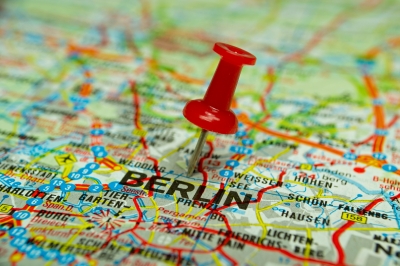 November 9th, 2009, marks the twentieth anniversary of the fall of the Berlin Wall. The wall not only divided the largest city in Germany into two sectors with different political systems, but was part of the Iron Curtain, a political divide separating democratic Western Europe from communist Eastern Europe. Moreover, the wall provided a physical focus on the human effects of the Cold War between the Eastern and Western worlds. Berlin was situated in the heart of the communist East Germany, and so West Berlin, as the democratic part of the city, was surrounded like an island by the communist Germany.
November 9th, 2009, marks the twentieth anniversary of the fall of the Berlin Wall. The wall not only divided the largest city in Germany into two sectors with different political systems, but was part of the Iron Curtain, a political divide separating democratic Western Europe from communist Eastern Europe. Moreover, the wall provided a physical focus on the human effects of the Cold War between the Eastern and Western worlds. Berlin was situated in the heart of the communist East Germany, and so West Berlin, as the democratic part of the city, was surrounded like an island by the communist Germany.
In 1945, when Germany lost the Second World War, the four allied forces -- USA, Great Britain, France and the Soviet Union -- divided Germany in four parts. What came to be known as East Germany was placed under the rule of the Soviet Union, the eventual West Germany under the rule of the three western Allies. The capital Berlin also was divided into four sectors: East Berlin later became the capital of East Germany, and the three western sectors formed West Berlin.
In the 1950’s the standard of living in the West increased enormously. In East Germany the development was very much slower. The people in the East suffered under the communist system which did not allow free political elections. East Germany was ruled by a small group of politicians who got their political education in Moscow, in the era of Josef Stalin. This was the reason that hundreds of thousands of mostly young and educated people fled from East to West Germany. In the beginning of the 1960’s, the government in East Berlin understood that East Germany would not be able to survive much longer if they could not stop this bleeding of the population. They came to the conviction that only a completely closed border would solve the problem.
In August of 1961, East Germany suddenly closed all checkpoints that marked border crossings to and from East and West Germany. Through the heart of Berlin, they built a high concrete wall. Along the border with West Germany, they created an impenetrable system of watch towers, fences, self-firing devices, all controlled and patrolled by thousands of military guards. None of these efforts were made to protect East Germany from western enemies but rather to keep their own population from leaving the country! As a consequence, German families were separated: brothers and sisters, parents and children. By order of the government, the military guards were instructed to shoot people trying to cross the border from East to West. Hundreds of people were killed in the course of time. Even today no one knows the exact number of casualties.
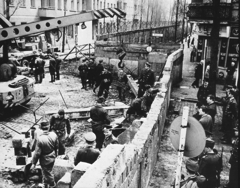
East Berliners (left) build the Berlin Wall
Access to West Berlin from West Germany and vice versa had been guaranteed by agreements between the allies. In fact, that meant that West German citizens were allowed to cross East Germany by airplane, train or car on special transit ways, to get to West Berlin.
Though the political situation between East and West Germany improved after 1972, as a result of agreements between the two states called “Ostverträge”, major differences remained. Overall, the standard of living was still much lower in Eastern Europe. There was no political freedom and people were not allowed to travel to the Western countries. The population of East Germany, however, was in a unique situation. Like Poland, Czechoslovakia, Hungary and Bulgaria, East Germany was completely under communist control, but the East Germans always could compare their system with West Germany and their personal lives with the lives of their relatives and friends in the West. Everyone had daily information available to them via Western radio and television.
In 1979, I left the little West German town of Schwerte, where I was born, to study Near Eastern Archaeology in West Berlin. In the summer of 1989, the political situation in East Germany and everywhere in the Eastern European countries started to change. By then I had finished my studies and worked at the German Archaeological Institute. I had met and married my wife, Brigitte. Like everyone else in Germany, Brigitte and I were fascinated with everything that was going on and wondered how things would turn out.
In October of 1989, East Germany was to celebrate its 40th anniversary. The Prime Minister, Erich Honecker, had foretold that the Berlin Wall would stand for the next hundred years. But, the economy of East Germany was in dire straits. The Russian Premier, Mikhail Gorbachev, had started his politics of ‘glasnost and perestroika’ -- ‘openness and restructuring’. East Germany’s Honecker, however, was not willing to take part in any political change. The East German population, however, had had enough of things the way they were. In the East German city of Leipzig, one church started what they called “peace prayers”, and every Monday thousands of people came to the church with candles in their hands. Soon, throughout East Germany, hundreds of thousands of people came together every Monday to demonstrate, shouting the slogan “We are the people” (Wir sind das Volk). Because of the self-image of the communist party, this was a strong provocation: the party had always claimed the right to be the voice of the people!
In August of 1989, Hungary and Austria organized a festival for the youth of both countries at their common border. By then, Hungary had opened its border to Austria, and many young people (to a large extent specifically East Germans) had taken the chance to flee immediately. From that moment on, thousands of East Germans, most of them travelling on vacation, tried to find a way to leave their country as well. In Czechoslovakia’s capital of Prague alone, thousands climbed the fence around the West German embassy asking for help. The situation then escalated in the surrounding countries, and even in East Germany itself. Some years later, an old politician of East Germany said: “We were prepared for everything, but not for candles and prayers.”
In the face of all the turmoil, in October of 1989, East German Prime Minister Erich Honecker was relieved of his duties, but his successors also could not stop the push of the people towards freedom. It was too late. Gorbachev was right in the end: “The one who comes too late will be punished by life.”
In the evening of November 9, 1989, in a press conference, a journalist asked a member of the “politburo” (the group of government leaders) about freedom of travel. This politician, Günter Schabowski, pulled a tiny sheet of paper out of his pocket and said: “Yes, as far as I can see, the checkpoints will be open from now on.” After this pronouncement, thousands and thousands of East Berliners flocked to the checkpoints along the Berlin Wall separating East and West. The guards did not know anything and had no orders to act or react. It is like a miracle that in this one night everything happened without any violence. Shortly before midnight, the checkpoints along the wall in Berlin were opened and hundreds of thousands of East Berliners crossed the border to West Berlin.
In 1989, West Berlin had 2.2 million inhabitants, and East Berlin 1.1 million. In the weekend after the checkpoints were opened, 1 million East Germans visited West Berlin on Saturday and 1 million again on Sunday.
The border between East and West Berlin was finally open, and the wall fell.
Part II. A Personal Perspective
Like everyone else in Germany, we were very much interested in what was going on in these months and therefore never missed the TV news. In the evening of November 9th, we had seen the East German politician Schabowski telling journalists that the wall would be open. That night I heard and saw East German cars passing our home, honking loudly, and I woke Brigitte with: “The East Germans are here!!!” I had been ill that day, with a high fever, so we hadn’t gone out to see what was happening. Early in the morning, Brigitte got up and switched on the TV. Still ill, I sat in front of the TV from 7 o’clock in the morning until 11 or 12 p.m., always looking at the same scenes showing tens of thousands of people running across the border.
From then on, every day something changed. We lived just 150 meters away from the Berlin wall and I went there every day with my camera, to see and document the change. It was a memorable sensation every time.
The Berlin Wall fell: that doesn’t mean that the construction was demolished in just a few days, but at different places in the wall, the East German government opened check points where people could cross the border in both directions. A big difference now was that there were no guards on the watch towers; at least none instructed to shoot anyone. The public mood was one of optimism and exuberance. What was happening was incomparably great. The most used word that winter was “Wahnsinn”, literally meaning insanity, but it was widely intended to mean something more like insanely great.
Everyone in Berlin went to the wall as often as possible, to have a look at what was going on. Every time I went there something was new. I remember an East German military boat full of western “visitors”. Some days earlier, this boat had been used for stopping people from crossing the river Spree in Berlin. Now, the guards had no order even to stop people from entering their boat! On the same day, I found an abandoned watch tower and climbed up onto it. One week before, this would have been unthinkable. Very close to that place was a hole in the wall of about one meter in diameter. A young man from West Berlin kept on throwing a stick over the wall. His little dog jumped through the hole in the wall over and over again to get the stick back from the former “Todesstreifen” (death strip), the space between the two parallel walls, where the East German soldiers had patrolled just days before.
There were lots of those little funny and crazy personal stories in a time of unbelievable political changes. The Brandenburg Gate, now the symbol of a unified Berlin, but then still belonging to East Berlin, was open now. Because the empty space at the gate, the “Pariser Platz” (Paris Square) was asphalted and large enough, our four year old daughter Sarah was perhaps the first person learning to ride a bicycle on that square – a place where unauthorized people had not been allowed to go for 28 years.
The Brandenburg Gate before the fall of the Berlin Wall
The demolition of the wall itself took some time, but it only took 11 months until Germany was politically reunited. Physically, the wall had gone, but in our mind it still existed for much longer. It took me some years to be able to cross the former border without thinking “Here was the border”.
Now, already for many years, I have been working with many colleagues from both East and West Berlin at the Pergamon Museum, situated in the former East. In the last twenty years, the East and West Germans have done a lot to be one people again. I personally have the feeling that we have been successful. The younger generation here does not have any direct memory of the time when East Germans could never visit their family or friends in the West.
The Berlin Wall is part of history. We, the witnesses of forty years of the political and practical division of Germany, and of the Iron Curtain in Eastern Europe, have a duty to keep the memories alive for future generations.
The history of the Wall tells us that people can be denied their freedom for a while, but not forever.
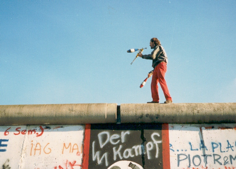
^ Freedom at last – A Juggler on the Berlin Wall, November 1989
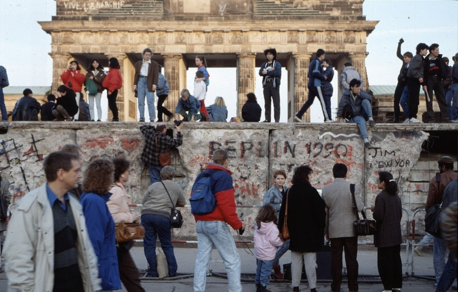
^ The Berlin Wall at the Brandenburg Gate.
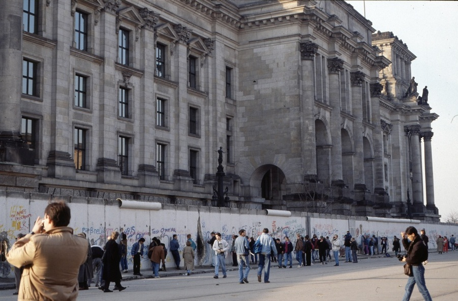
^ Inside the former “ Death Strip” - behind the Reichstag, today the parliament of Germany.
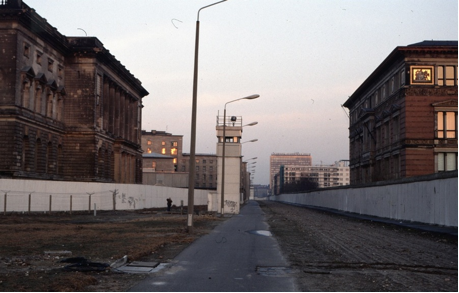
^ Abandoned guard tower inside the “Death Strip” - West Berlin to the right, East Berlin to the left.
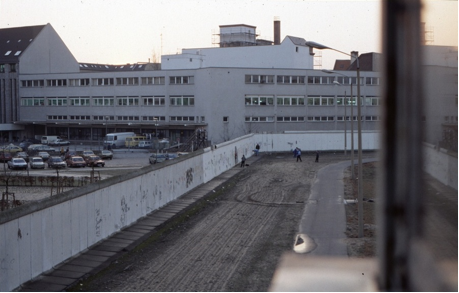
^ A view from a guard tower into the former “Death Strip” - the West is to the left.
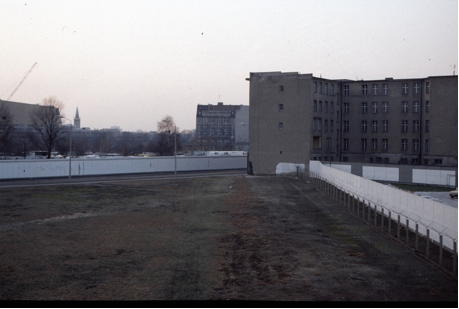
^ The Berlin Wall system: the “Death Strip” was between two walls and a fence. West was to the left, the East to the right.
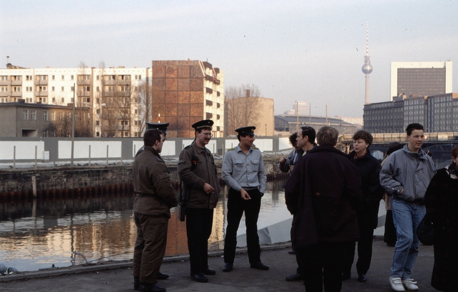
^ The river Spree belonged to the East. Behind the river is the back wall and East Berlin. Here, East German guards interact peacefully with Western visitors.
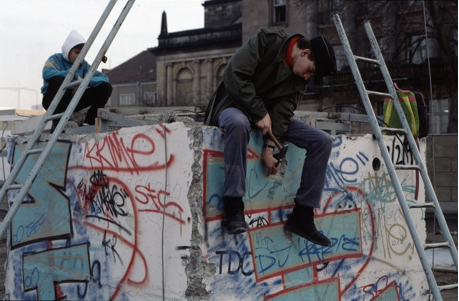
^ The word “Mauerspecht” (Wall Woodpecker) was created in 1989 because of the sound of hammers chiseling away at the Berlin Wall. Thousands of people “helped” in this way to demolish the wall.
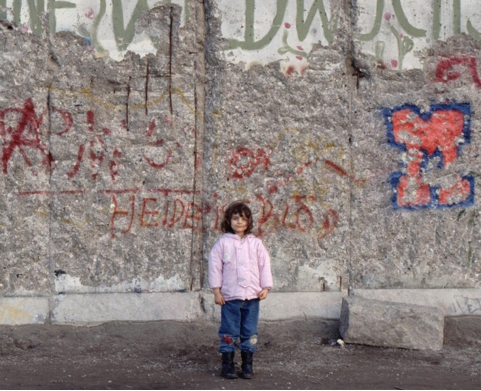
^ The section of the Berlin Wall behind Sarah Pedde (Friedhelm’s daughter) already shows damage by the “Mauerspechte”.
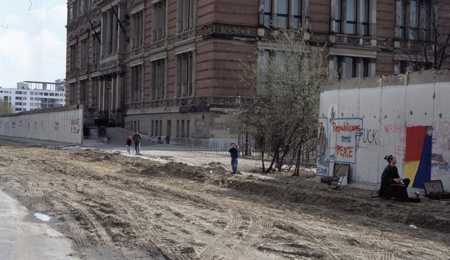
^ The Berlin Wall comes down: Beyond the gap is West Berlin.
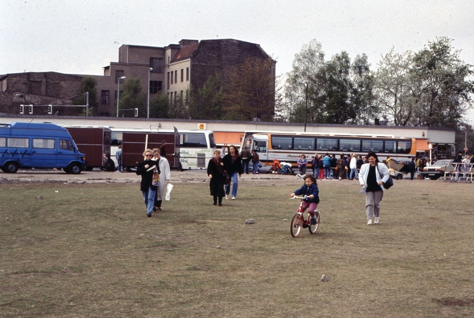
^ Sarah learns to ride her bicycle in the former “Death Strip” separating East and West Berlin as her mother Brigitte Pedde supervises.
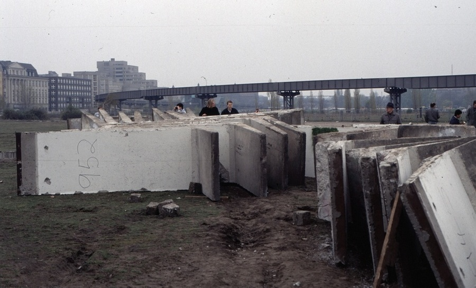
^ Segments of the demolished Berlin Wall, deposited in the former “Death Strip”. In the background to the left, in the brown building with the white windows is where Friedhelm Pedde’s family lived.